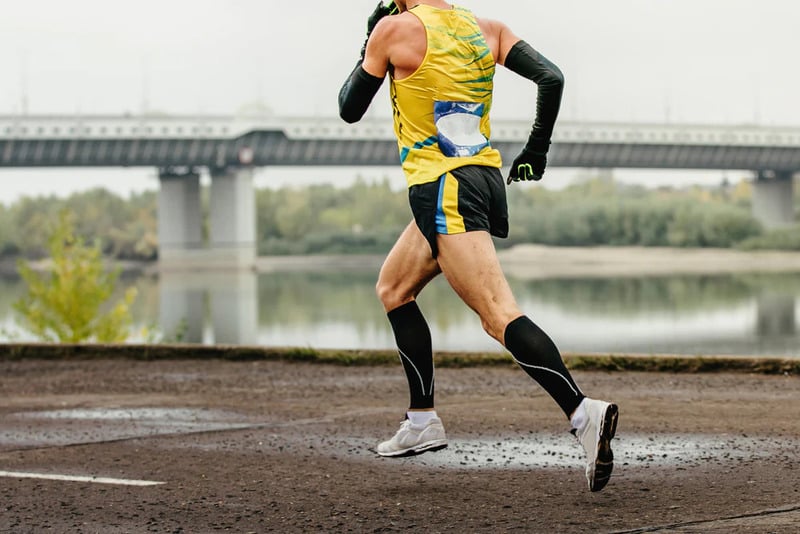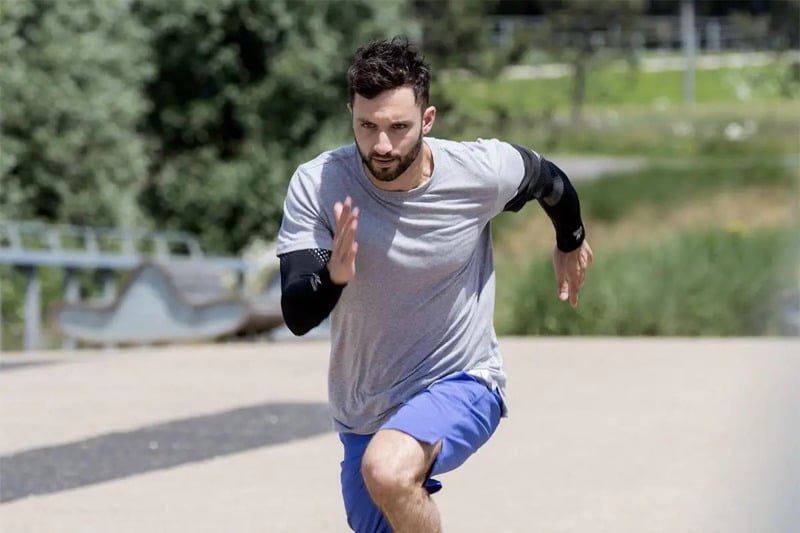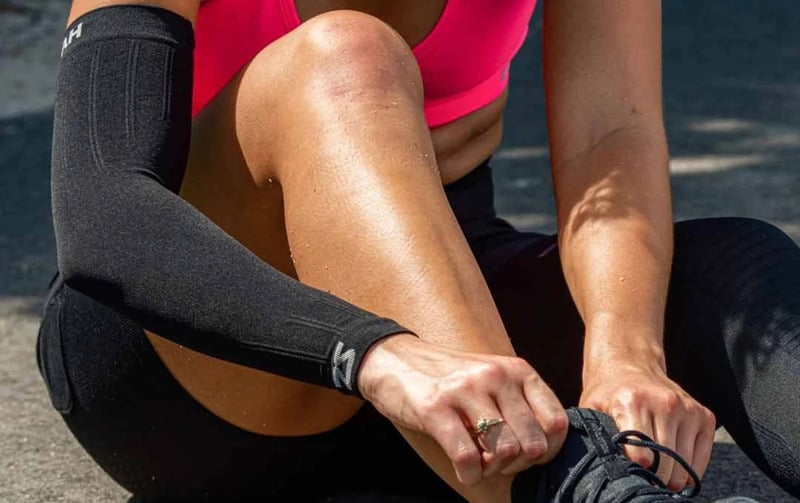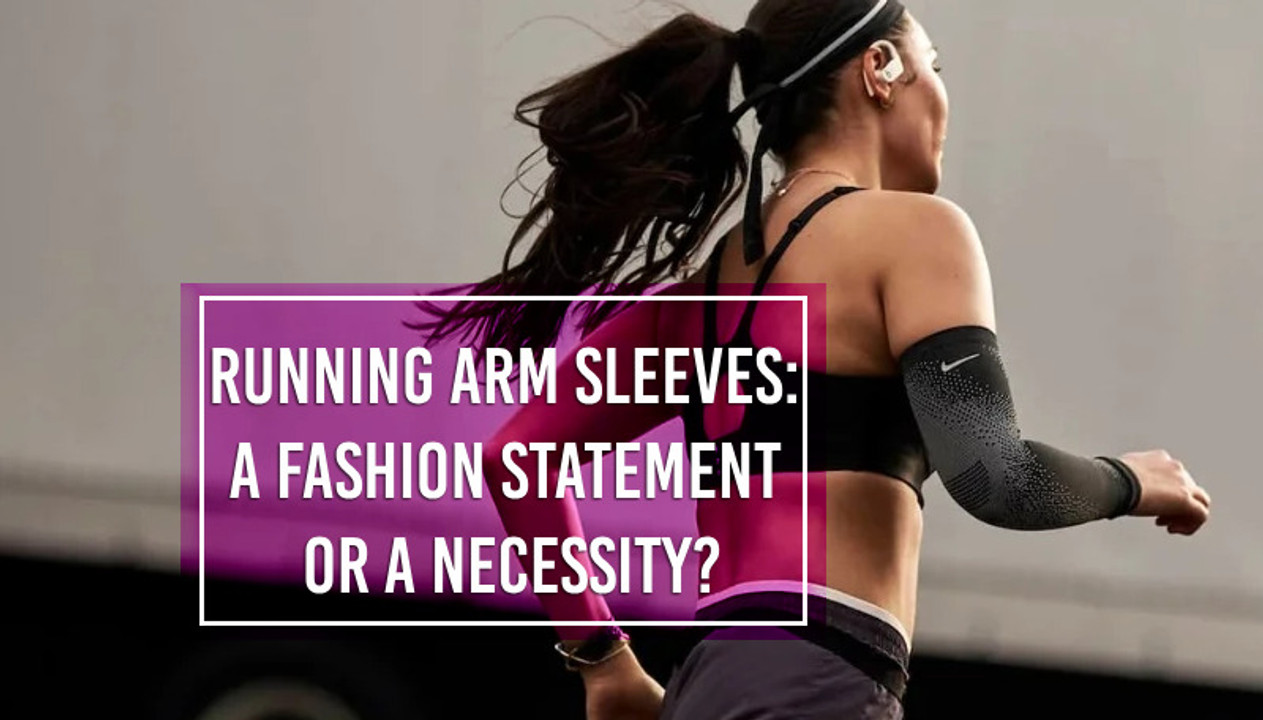Running Arm Sleeves: A Fashion Statement or a Necessity?
Sports enthusiasts have attributes that can easily distinguish them from people in the crowd. The first thing that comes to mind about runners is running shoes, obviously, but those have long ceased being exclusive. Arm sleeves, on the other hand, are a common accessory in several sports, including running, that are not worn by regular people. Running arm sleeves have long become a common sight at races and on running trails. They're sported by everyone from marathoners to sprinters, but many people see them as nothing more than a fashion accessory. Is this really the case for arm sleeves? Let’s take a closer look.

What are Running Arm Sleeves?
Running arm sleeves are basically tube-shaped garments that cover the arm from the wrist to the upper arm, sometimes extending up to the shoulder. They come in various materials and thus may boast different properties, from moisture-wicking to insulation or cooling. For that reason, they are sometimes called arm warmers, though not all arm sleeves for running have warming properties. However, the majority of running sleeves do have one feature in common - they are very elastic, which comes with health benefits of its own.
The Practicality of Running Arm Sleeves
Even though running arm sleeves may indeed add to the appeal of your running outfit, they are much more than just a fashionable accessory. In fact, fashion came second after function, as it often does. Arm sleeves for running were initially introduced to improve wearers’ performance, comfort and health. Though there is no set-in-stone classification, not all arm sleeves are the same. For convenience’s sake, we’ve singled out three types of arm sleeves to cover their associated benefits: compression arm sleeves, arm warmers and arm coolers.
Compression Arm Sleeves
Compression sleeves are the most widely used type out there. Many arm warmers and coolers also boast compression properties, but compression sleeves are the basis on which other types are built.
The compression provided by these sleeves enhances blood circulation in the arm, which, in turn, improves muscle oxygenation and nutrient delivery. Compression arm sleeves also reduce muscle fatigue and significantly speed up recovery time - both are benefits that all runners, regardless of their experience or health conditions, can benefit from. Additionally, the compression from these sleeves reduces muscle vibration, the factor that contributes to muscle soreness and may bring about long-term injuries like tendonitis.
Arm Warmers
As the name suggests, arm warmers are designed to keep runners (or at least their arms) warm during cold weather. Some of you might not wear your warm-weather running apparel when it’s cold, so it might not be that big of an issue. However, arm warmers can be a way to avoid donning additional layers, and the lighter you are, the easier it is to run. Arm warmers act as an insulating layer, trapping body heat to keep your muscles warm and flexible, which reduces the risk of strains and pulls and helps you stay on track.
Arm Coolers
Conversely, arm coolers are made from breathable, moisture-wicking materials like polyester or nylon, making them perfect for hot weather. You might feel like not wearing any additional garments when it’s hot outside, but from a health-focused point of view, that’s not the best choice. Arm coolers draw sweat away from the skin, promoting faster evaporation and helping to keep the body cool during a run. Thus, you will be less likely to overheat and won’t be so sweaty. Sounds like a win-win to me.
UV-Protection
Beyond these specific functions, running arm sleeves also provide secondary benefits. Many arm coolers and compression arm sleeves are designed with UV-protective materials that shield your skin from harmful ultraviolet rays during outdoor runs. This is a crucial feature for runners who spend a lot of time running in the sun, as it prevents sunburns and long-term skin damage, not to mention reducing the risk of skin cancer.
Physical Protection
Furthermore, running arm sleeves offer a degree of physical protection. If you are a trail runner who has to navigate your way through shrubs and thickets, arm sleeves can be a real asset. They can defend your arms from scratches, cuts and abrasions, and those, even if tiny, are never pleasant.
Brightly-colored arm sleeves can also increase your visibility on the road. You might say it has little to do with physical protection, but hey, if it increases your chances of not being run down, it sounds like a great body protector.

Choosing the Right Running Arm Sleeves
It might seem like there is little decision-making involved in choosing an arm sleeve for running, but there are some things you should consider. If you want to get the maximum benefit from them, that is. Here are some key aspects to keep in mind:
Size
Arm sleeves come in various sizes - typically small, medium, large, and extra-large. To find the right size for you, measure the circumference of your bicep and compare it with the manufacturer's sizing chart. If the sleeves are too tight, they can impede blood flow instead of stimulating it; if too loose, they may not provide the desired compression and could slide down easily during your run.
Fit
The fit of the arm sleeve is also important. Arm sleeves should fit snugly but not restrict movement. They should cover the majority of your arm without causing discomfort. Look for sleeves with elastic cuffs or silicone grippers at the top edge to prevent them from slipping down.
Properties
Consider the specific properties you need from your arm sleeves. Do you need them for warmth (arm warmers), cooling (arm coolers), or muscle support (compression sleeves)? And don’t forget about UV protection, that factor also helps. The trick here is to read the product description or the label - it would be disappointing to buy an arm sleeve for running in warm weather only to see it has no sun protection. Identify your needs and choose the sleeves that offer features that can meet them.
Material
Material choice is closely related to the properties you're after. For instance, if you need arm warmers, look for thermal materials like wool or fleece. If you're after cooling and sweat-wicking properties, opt for breathable synthetic materials like polyester or nylon. For compression, a blend of nylon or polyester and spandex might be the best option.
Colors
This one is more of a preference question, but we have some recommendations here as well. First, choose from the colors you like - you are less likely to put on something you don’t enjoy looking at. Second, consider how easily stained that color is. Darker colors are better at concealing stains, so you don’t need to wash them that often. Brighter colors will immediately show dirt, but they have a benefit to make up for it. Bright arm sleeves are more noticeable, so all traffic participants will be more likely to notice you in dim light conditions. Reflective arm sleeves will perform best at this, but regular ones can fill in that role too.

The Debate: Fashion Statement or Necessity?
Now let’s return to the very question that crowns this article. Like many elements of sports gear, running arm sleeves straddle the line between form and function, offering both practical benefits and aesthetic appeal. Is one of these functions dominant? Let’s figure out.
Running Arm Sleeves as a Necessity
From a functional perspective, running arm sleeves are indeed a necessity for many runners. As previously discussed, the benefits they offer are just too good to pass.
Compression sleeves offer much-needed muscle support, reducing fatigue and aiding recovery. Arm warmers provide warmth during cold weather runs, helping to maintain muscle temperature and prevent injuries. Arm coolers help regulate body temperature during hot weather runs, preventing overheating and promoting comfort.
Furthermore, many arm sleeves have UV protective properties, protecting runners from harmful sun rays during outdoor runs. They also offer a degree of physical protection, guarding against scratches and abrasions when running through rough terrains.
From how it looks, arm sleeves for running are much more than just fashion statements.
Running Arm Sleeves as a Fashion Statement
But the function is not everything. Running arm sleeves have undeniably become a fashion statement in the running community, one other means to express yourself. Available in a myriad of colors and patterns, arm sleeves for running allow runners to shape their personal style and stand out from the crowd.
Some runners coordinate their arm sleeves with their running outfits, while others choose bold, vibrant colors or designs to make a statement. This aspect of personal expression can add an element of fun and motivation to running, making it an enjoyable activity rather than just a workout routine.
So, what’s the verdict? Function and fashion are not mutually exclusive. Though a passerby might only see a fashion accessory, running enthusiasts know how useful arm sleeves really are. They combine good looks with helpful features, and runners can take advantage of both of these benefits at once.Check out our other articles on running accessories:
- GPS Fitness Tracker: How to Always Stay on Track
- How a Running Belt Can Improve Your Run
- How Reflective Running Gear Enhances Safety During Nighttime Runs
- Best Running Gear: A Look at 2023's Top Products
FAQs
What are running arm sleeves?
Running arm sleeves are accessories worn by runners that cover the arm from the wrist to just below the shoulder. They provide a range of benefits, including temperature regulation, muscle support, and protection.
What are the different types of running arm sleeves?
The three main types of running arm sleeves are compression arm sleeves, arm warmers and arm coolers.
What benefits do compression arm sleeves provide?
Compression arm sleeves enhance blood circulation, reducing muscle fatigue and speeding up recovery time. They also help reduce muscle vibration, which can lead to muscle soreness and long-term injuries.
How do arm warmers keep runners warm during cold weather?
Arm warmers act as an insulating layer, trapping body heat to keep your muscles warm and flexible.
How do arm coolers help regulate body temperature during hot weather runs?
Arm coolers are made from breathable, moisture-wicking materials that draw sweat away from the skin. This promotes faster evaporation and helps to keep the body cool, preventing overheating during a run.
Do running arm sleeves provide UV protection?
Yes, many running arm sleeves are designed with UV protective materials that shield your skin from harmful ultraviolet rays during outdoor runs. However, not all of them feature this benefit, so make sure to read the product description attentively to avoid dissatisfaction.
What properties should I consider when selecting running arm sleeves?
Consider the specific properties you need from your arm sleeves, such as warmth (for cold weather), cooling (for hot weather), compression (for muscle support), UV protection, and physical protection.
What materials are commonly used for running arm sleeves?
Common materials used in running arm sleeves include wool or fleece for warmth, polyester or nylon for cooling and sweat-wicking, and a blend of nylon and spandex for compression.
EXPLORE POPULAR ARTICLES
-
How to Break In Running Shoes [Expert Guide]
Jun 20th 2024It's rare when a couple of short walks around the block is enough for a runner to break in a new pai
-
goodr sunglasses: Choosing the Perfect Pair
May 24th 2024Runners and outdoor fitness enthusiasts know how important good sports sunglasses are. They prote
-
Selecting the Best Running Shoes for Heavy Runners
Mar 28th 2024Running ranks on the list of activities anyone can enroll in. You don’t need any specific equipme



![How to Break In Running Shoes [Expert Guide] How to Break In Running Shoes [Expert Guide]](https://cdn11.bigcommerce.com/s-eeul26hjka/images/stencil/160w/uploaded_images/how-to-break-in-running-shoes.jpg?t=1718884434)

